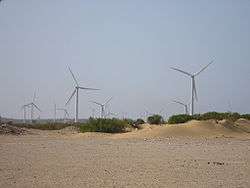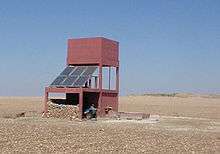Renewable energy in Morocco
Renewable energy in Morocco represented 0.4% of the national energy balance (excluding biomass) and nearly 10% of electricity production in 2007. Renewable energy is supported by strong hydropower sources and the newly installed wind energy parks (147 MW installed and 975 MW under deployment). Morocco plans a $13 billion expansion of wind, solar and hydroelectric power generation capacity and associated infrastructure that should see the country get 42% of its electricity from renewable sources by 2020.[1] The Moroccan government is keen on increasing renewable energy production, as Morocco's January–September oil bill reached about USD 1.4 billion in subsidies in 2009, registering a fall of 57.9% compared to 2008.[2]
Morocco has a bold target of sourcing more than half of its electrical energy from renewable sources by 2030 and a plan to have 2,000 MW of wind and 2,000 MW of solar power plants by 2020, looking to add 1.5GW renewable capacity annually. These targets, alongside other climate change policy, helped Morrocco be rated second most prepared country in the 2018 and 2019 Climate Change Performance Indexes.[3]
Industry
Despite huge wind and solar potential, it is too early to say when Morocco could begin exporting renewable electricity to Europe from projects such as the $400 billion Desertec initiative. It is unclear whether the Desertec consortium's planned investment in solar thermal energy across North Africa could go into Morocco or how much power could eventually be exported to Europe. Desertec's plans are likely to need several years more of feasibility studies.
Renewable energy plays a key role in ONE's $3.4 billion energy development plan, announced in January 2004. The goal is to provide 80 percent of rural areas with electricity by 2008, while increasing the share of renewable energy from 0.24 percent in 2003 to 10 percent in 2011. The plan calls for two new wind projects, as well as a 200 - 250-MW thermo-solar facility in d’Ain Beni Mathar, of which 30 MW will be generated from solar power. One of the wind power facilities (60 MW) will be located in Essaouira, while the other (140 MW) will be located near Tangiers. The Essaouira facility is scheduled to come on-line in 2007.
Morocco has additional renewable resources that could be developed, which the countries four perennial rivers and many dams with hydroelectric potential. In May 2005, ONE selected Temsol for a $27.6 million project to supply solar power to 37,000 rural homes by 2007. Similar contracts were awarded in May 2002 to a consortium led by Total Energie and in January 2004 to Apex-BP. Currently, only 55 percent of outlying villages have access to electricity.
Alstom, a French company building a high speed rail link between Tangier and Casablanca, will also build power generation facilities with a capacity of 470 megawatts to energize the rail link. While most of the capacity will come from standard gas combined cycle combustion, 20 megawatts will be from solar power.[4]
Wind power


In terms of wind power development, Morocco enjoys quite favourable wind resource patterns, both in the northern part of the country near Tanger and to the west where certain regions benefit from regular trade winds.
In 2013, 5,05% of electricity produced in Morocco was coming from wind power.[5]
Wind power could be a major contributor in the electricity sector of Morocco. According to data presented by minister Amara in Madrid in 2015, the country’s onshore potential is estimated at 25 GW, of which 6 GW could be installed by 2030. The average wind speed is 5.3 metres per second (m/s) at more than 90% of the country’s territory, according to the wind atlas, developed by the Moroccan Renewable Energy Development Center (CDER). The Tanger and Tetouan region (North of Morocco) measured particularly high at 8 to 11 m/s, and 7 to 8.5 m/s were recorded for Dakhla, Tarfaya, Taza and Essaouira.
The installed capacity 2014 was 750 MW. According to data from Morocco's energy ministry, a total of 220 MW of private wind energy projects have been built until the end of 2016. Another 120 MW are to go online soon at the Khalladi wind farm in the vicinity of Tangiers, northern Morocco. The European Bank for Reconstruction and Development (EBRD) and Banque Marocaine du Commerce Exterieur (BMCE) have announced they will provide a financing package of EUR 126 million (USD 133.3m) for the development of the project.
The objective is to generate 2,000 MW by 2020.[6]Solar power


Solar power in Morocco is enabled by the country having one of the highest rates of solar insolation among other countries— about 3,000 hours per year of sunshine but up to 3,600 hours in the desert. Morocco has launched one of the world’s largest solar energy projects costing an estimated $9 billion. The aim of the project is to create 2,000 megawatts of solar generation capacity by the year 2020.[7] Five solar power stations are to be constructed, including both photovoltaic and concentrated solar power technology. The Moroccan Agency for Solar Energy (MASEN), a public-private venture, has been established to lead the project. The first plant will be commissioned in 2015,[8] and the entire project in 2020[9]. Once completed, the solar project will provide 38% of Morocco’s annual electricity generation.
Morocco, the only African country to have a power cable link to Europe (2,100 MW [10]), aims to benefit from the €400bn ($573.8bn) expected to come from the ambitious pan-continental Desertec Industrial Initiative.National policy
In November 2009 Morocco announced a solar energy project worth $9 billion which officials said will account for 38 percent of the North African country's installed power generation by 2020.[11] Funding would be from a mix of private and state capital. The ceremony was attended by U.S. Secretary of State Hillary Clinton and the Moroccan king.[11] The project will involve five solar power generation sites across Morocco and will produce 2,000 megawatts of electricity by 2020.[11] The project would add in terms of power generation the equivalent of the current electricity consumption of the country's commercial capital Casablanca. Germany has expressed its willingness to participate in the development of Morocco's solar energy project[12] which the country has decided to carry out, as did the World Bank.[13] Germany will also take part in the development of a water-desalination plant.[12]
A net energy importer, Morocco launched the National Renewable Energy and Efficiency Plan in February 2008 to develop alternative energy to meet 15% of its domestic needs and increase the use of energy-saving methods.[14][15] The plan is expected to create more than 40,000 jobs and stimulate over €4.5bn in investment by 2020. The National Plan for the Development of Solar Thermal Energy, formulated in 2001, aims to install 440,000 solar-powered water heaters by 2012, of which 235,000 are completed.[14] The Moroccan government plans to produce 40% of its energy from renewable sources by 2020.[16]
In 2008 Morocco announced plans for a new campus providing knowledge-based services to strengthen research and training in clean technology. The campus is part of a US$219 million clean energy industrial park being built in the eastern city of Oujda to support private sector investment as well as renewable energy companies. Building is underway, and the campus is expected to open by 2010.
Many initiatives are dedicated to renewable energy such as solar power plants, pumping stations, hydraulic turbines, waste recycling, water pumps, sea water desalination, air conditioning and solar water heaters. RE is also the focus of many economic and social programs, as in the case of rural electrification, where individual photovoltaic solar systems account for 7% of energy production.
Since December 2015, the prices of fuels obey the free play of supply and demand.[17]
Forecast
Energy sources are significant. Forecasts estimate wind energy potential at 6 GW, the solar heater market at 1M m2, and highlight strong potential for biomass enhancement (9 million hectares of wooded areas).[18] The expectations in this field are high among institutional stakeholders, economic players and also consumers.
There are four main obstacles to incentives and institutional approaches:
- Regulations are lacking;
- Renewable energy and energy efficiency are low priorities for national development programs dedicated to raising awareness and to ensuring sustainable demand in RE and energy efficiency technologies and services;
- Taxation does not provide attractive market conditions.
See also
- Wind power in Morocco
- Solar power in Morocco
- Renewable energy by country
References
- http://www.zawya.com/pdfstory.cfm?storyid=ZW20091109000145&l=035354091110
- http://www.moroccobusinessnews.com/Content/Article.asp?idr=20&id=1241
- "MOROCCO: Ranked second worldwide in climate change control". Afrik 21. 2020-04-30. Retrieved 2020-05-29.
- "Green Technology and Environmental Science News: Solar Power for New Moroccan Rail Line". enn.com.
- L’énergie éolienne turbine
- Ouverture à Casablanca des offres techniques de l'ONEE
- AfDB helps fund $1.44bn Moroccan solar project
- Morocco Building 500 MW Solar Power Project
- Louis Boisgibault, Fahad Al Kabbani (2020): Energy Transition in Metropolises, Rural Areas and Deserts. Wiley - ISTE. (Energy series) ISBN 9781786304995.
- Farge, Emma. "Morocco to upgrade power link with Spain". U.S. Retrieved 2018-11-22.
- "Morocco unveils $9 bln solar power scheme". reuters.com.
- http://www.moroccobusinessnews.com/Content/Article.asp?idr=20&id=1252
- "Projects : INTEGRATED SOLAR COMBINED CYCLE POWER PROJECT - The World Bank". worldbank.org.
- "Archived copy". Archived from the original on 2009-08-25. Retrieved 2009-12-23.CS1 maint: archived copy as title (link)
- "Morocco invests US$3.2 billion in renewable energy". SciDev.Net.
- http://www.map.ma/eng/sections/economy/morocco_to_produce_4/view
- "Morocco ends gasoline, fuel oil subsidies".
- http://www.planbleu.org/publications/atelier_energie/MA_Summary.pdf
External links
![]()